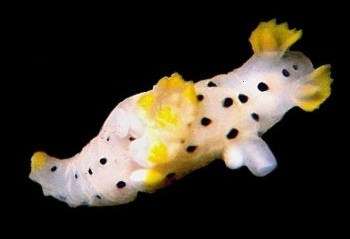
Thecacera darwini
Pruvot-Fol, 1950
Order: NUDIBRANCHIA
Suborder: DORIDINA
Family: Polyceridae
Subfamily: Polycerinae
DISTRIBUTION
Chile [known from nthn Chile to Tierra el Fuego]
PHOTO
Michael Schroedl. See page on Ismaila, copepod parasite of nudibranchs.
The animal is white with scattered spots. There rhinophore sheaths, the tips of the gills, and the posterior tip of the body are bright yellow. There is also a bright yellow subterminal band around the dorso-lateral processes on each side of the gills. Schroedl (2003) reports that this species is very common throughout the year in the intertidal and upper sublittoral, and feeds on the encrusting bryozoan Beania magellanica. He reports that central Chilean populations are heavily infested with the crustacean parasite Ismaila.
Thecacera darwini grows to at least 45 mm in length. It was first collected in 1845 by Charles Darwin during the famous voyage of the Beagle.
-
Pruvot-Fol, A. (1950). Le genre Thecacera Fleming, 1828 et une espece nouvelle: Thecacera darwini. Journal de Conchiologie, 90(1): 48-52
-
Schroedl, M. (2003) Sea Slugs of southern South America. ConchBooks, 165pp.
2003 (September 7) Thecacera darwini Pruvot-Fol, 1950. [In] Sea Slug Forum. Australian Museum, Sydney. Available from http://www.seaslugforum.net/factsheet/thecdarw
